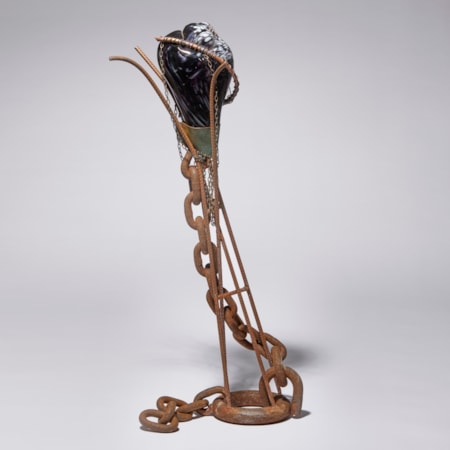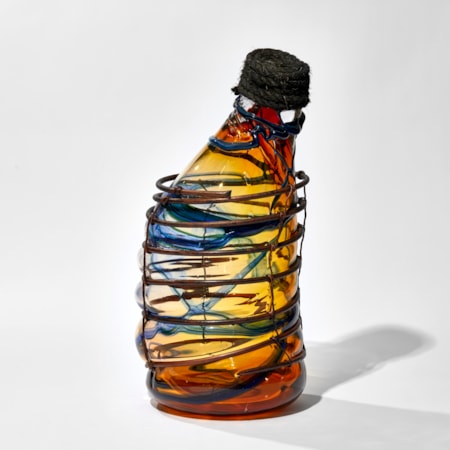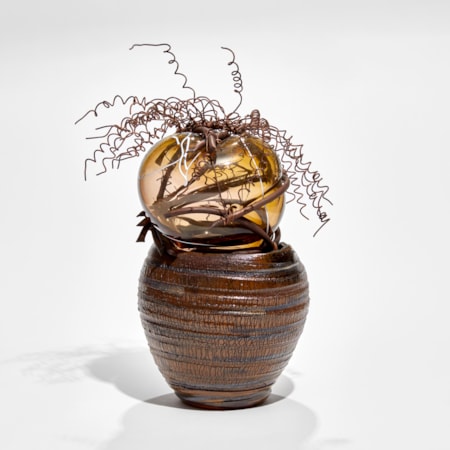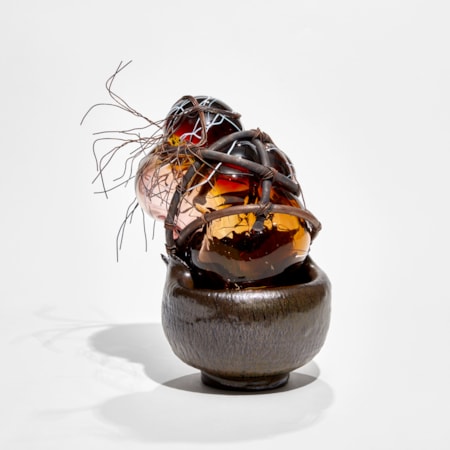Token Gesture
Artist
Title
Token Gesture
EDITION
Unique
dimensions
H 39 cm W 22 cm D 21 cm
Material
Blown & sculpted glass with mixed media
price
£ 3750
about
'Token Gesture' is a unique sculpture by the British artist, Chris Day, created from handblown & sculpted glass with microbore copper pipe, copper wire, copper and rope.
The brass trade played a vital role in Birmingham's industrial growth. Its connection to the slave trade lies in the production of 'manilla'. These were trading tokens that often ended up being used in the purchase of slaves in Africa.
Manillas were traditional African horseshoe shaped bracelets made of metals such as iron, bronze, copper and very rarely gold. Decorative manillas were worn to show wealth and status in Africa. Europeans used them as a form of currency in west Africa to buy and enslave African people. They manufactured them in Britain, especially around Bristol and Birmingham, based on African designs. Different styles and metals had different values. One source stated that, in 1505, one manilla was worth a big elephant tooth and eight to ten manillas would buy an African person to enslave.
Ships sailed from Britain to Africa, full of ‘exchange’ goods such as manillas, metals, clothing, guns and alcohol. Enslaved Africans were then transported across the Atlantic to the Americas. Raw materials such as sugar, tobacco and cotton, grown by enslaved Africans on plantations in the Americas, were then brought back to Britain where they were processed.
Historians estimate that at least 12 million Africans were removed by force during the transatlantic slave trade. Many millions died when they were captured and transported. Europeans dominated the trade in enslaved Africans using the power of guns. They justified enslaving Africans by claiming that they were ‘uncivilised’.
This information was provided by curators at The Manchester Museum.
The brass trade played a vital role in Birmingham's industrial growth. Its connection to the slave trade lies in the production of 'manilla'. These were trading tokens that often ended up being used in the purchase of slaves in Africa.
Manillas were traditional African horseshoe shaped bracelets made of metals such as iron, bronze, copper and very rarely gold. Decorative manillas were worn to show wealth and status in Africa. Europeans used them as a form of currency in west Africa to buy and enslave African people. They manufactured them in Britain, especially around Bristol and Birmingham, based on African designs. Different styles and metals had different values. One source stated that, in 1505, one manilla was worth a big elephant tooth and eight to ten manillas would buy an African person to enslave.
Ships sailed from Britain to Africa, full of ‘exchange’ goods such as manillas, metals, clothing, guns and alcohol. Enslaved Africans were then transported across the Atlantic to the Americas. Raw materials such as sugar, tobacco and cotton, grown by enslaved Africans on plantations in the Americas, were then brought back to Britain where they were processed.
Historians estimate that at least 12 million Africans were removed by force during the transatlantic slave trade. Many millions died when they were captured and transported. Europeans dominated the trade in enslaved Africans using the power of guns. They justified enslaving Africans by claiming that they were ‘uncivilised’.
This information was provided by curators at The Manchester Museum.

























